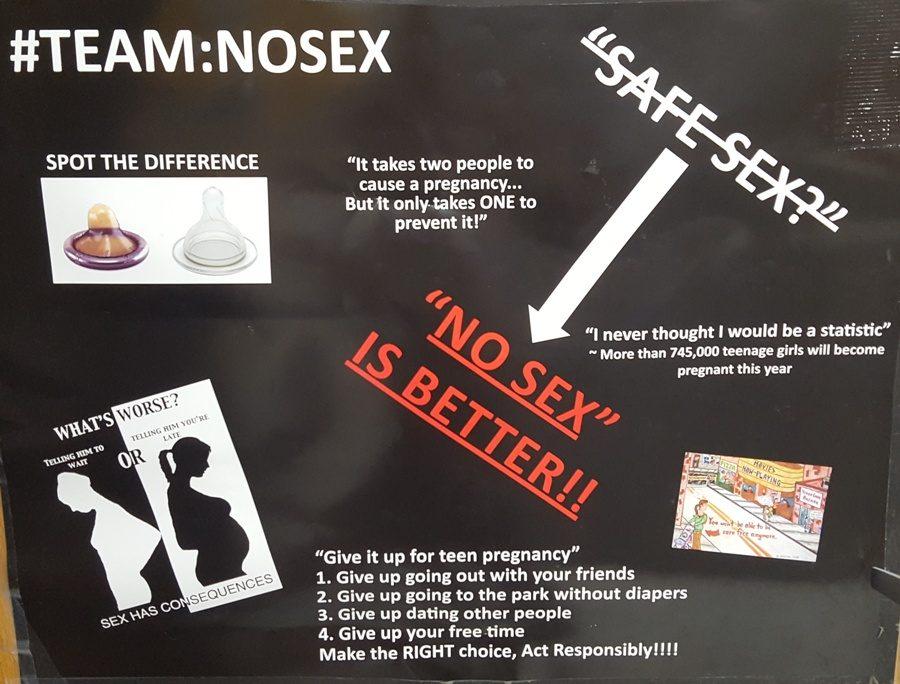Schools should abstain from abstinence-only education
A poster in the school nurse’s bathroom attempts to get students to practice abstinence. In reality, abstinence is not a realistic way for teenagers to avoid pregnancy or sexually-transmitted diseases. Instead, schools should educate students how to practice safe sex.
December 7, 2016
America doesn’t like talking about sex. To put it plainly, ours is a rather prudish nation — a villain in a children’s movie can take multiple shots at the protagonist and end up hanged from a tree, yet the suggestion of nudity or sex, or similar explicit topics, automatically gives the film a hard R-rating. It is almost cliché to say at this point, but when did simulated violence and gore become more acceptable for children than sex, the originator of almost every living creature?
In correlation with America’s rather Puritanical views, many state boards of education preach abstinence, a total withdraw from sex until marriage. While it is true that abstinence is the only surefire way to avoid sexually transmitted diseases or pregnancy, in the same way that you can never get eaten by a bear if you choose not to leave your home, this method of teaching is not only useless to students, but also harmful.
Teenagers have sex. It’s a fact of life. It’s nothing new. Despite what your grandparents say, teenagers didn’t start having sex when that dirty rock music came around, or because of that awful rap and hip hop. Teenagers have been exploring themselves and their sexuality since the dawn of time. To be frank for a moment, teens “do it.” After all, there’s a reason that you can buy condoms before you turn 18, isn’t there?
When school systems dedicate their health classes solely to teaching abstinence, they hurt the students who participate in those classes.
Your student’s average middle and high school health class health curriculum consists of slideshows of diseased genitals and videos of bad actors from the 1990s talking about how close they are to their significant other because they’re waiting for marriage. Thirty-nine states in America choose to introduce high school freshman to the idea of sex by showing infected genitalia, and theirs is a futile effort.
Unless you live in the secluded hills of Appalachia, where the sunlight doesn’t touch the ground, you know about sexually-transmitted diseases. Everyone does, just like everyone knows about normal diseases like chickenpox and the flu. They way you contract them is literally in the name.
What schools should be doing is teaching that sex is entirely natural. Don’t stigmatize something that isn’t inherently evil or horrifying. Teach that sex is a part of life, and is precisely where life begins. God forbid anyone suggest to a minor that sex is even the least bit pleasurable — that sex is an intimate, consensual mental and physical connection between two individuals and not just a means of reproduction.
According to the Guttmacher Institute, an organization dedicated to advancing sexual and reproductive health rights both globally and in the United States, from 2011-2013 more than 80% of adolescents aged 15-19 reported that they had received a formal education about STDs and how to say no to sex.
Only 55% of young men and 60% of young women had been given a formal instruction on methods of birth control.
How can you avoid a disease when you haven’t been given the information to do so? Yes, non-participation is a 100% sure-fire way to avoid getting anything, but a total lack of participation is an unrealistic expectation by lawmakers that are so far removed from high school education that they aren’t fit to preside over it.
The Center for Disease Control even released a report criticizing and condemning schools and lawmakers for teaching total removal and not realistic prevention.
When you dedicate all of your time to telling people not to have sex, you’re not preparing them for their eventual first time, and that is assuming every bright-eyed teenager won’t try something at least once before their graduation.
As part of their “America Left Behind” series, Ashley Creek of Al Jazeera America exposed the troubles with Alabama’s abstinence-only policies. Between 2004 and 2011, the Alabama Department of Health reported that people ages 13 to 24 were the only age group in the state to experience a sudden increase in HIV diagnoses. Come 2013, they accounted for almost half of new infections in the entire state. “A 2007 study commissioned by the federal government showed that abstinence-only education does not keep teenagers from having sex or having sex with more partners. Nor does abstinence-only education increase or decrease the likelihood that teenagers will use a condom,” Creek said.
According to the same article, Ali Simpson, an Alabama high school graduate, reported that her high school sex education consisted of a woman coming in and telling a story about how while she remained abstinent, her husband had had sex once before their marriage, and gave her an STD that rendered her infertile.
While that is a possibility, it remains very clear that officials are trying to scare students out of having sex. They plainly employ scare tactics, and while that seems like a harsh claim, there is really no other way to say it. School systems show these graphic pictures of inflamed, infected genitals and of men and women in horrific pain. They have speakers come in and tell horror stories of sex gone wrong and how it has ruined their life.
Schools are taking a part of life and spinning it into this horrific accident that can ruin your life. They give students a false dilemma between total abstinence and death. While the aim is to prevent STDs and teen pregnancies, evidence shows that abstinence-only education fails on both those fronts.
Abstinence-only education doesn’t work, and schools shouldn’t limit a student’s education. Abstinence-only education has good intentions, but it fails to prevent the inevitable. Schools can’t plug their ears and pretend that what they say is working. Instead, they should embrace the truth and properly prepare teenagers for sex.






